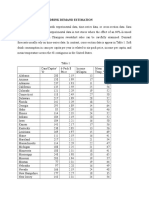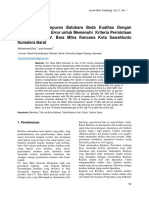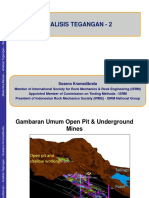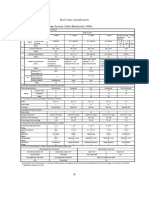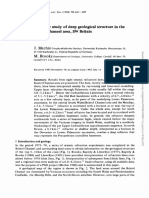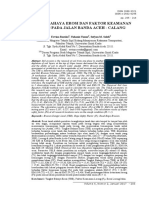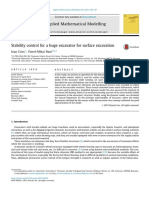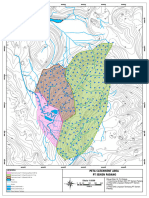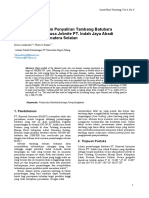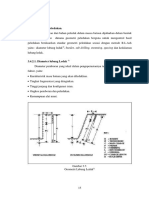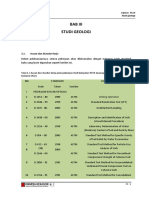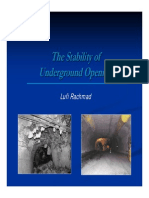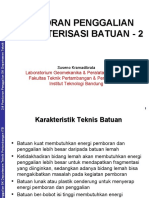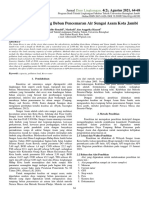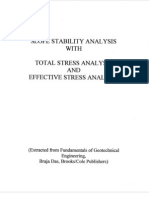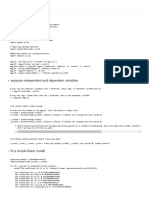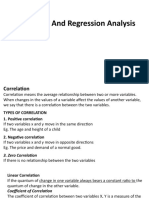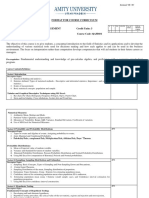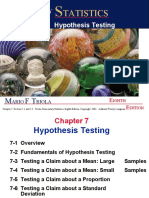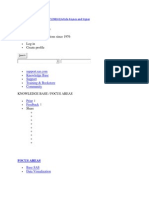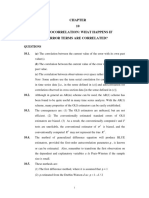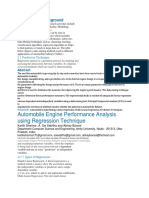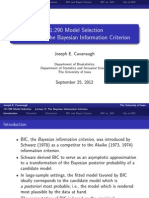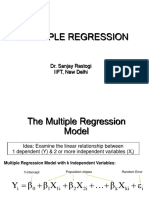Probabilistic Slope Analysis With The Finite Element Method: ARMA 09-149
Probabilistic Slope Analysis With The Finite Element Method: ARMA 09-149
Uploaded by
Maria TabaresCopyright:
Available Formats
Probabilistic Slope Analysis With The Finite Element Method: ARMA 09-149
Probabilistic Slope Analysis With The Finite Element Method: ARMA 09-149
Uploaded by
Maria TabaresOriginal Title
Copyright
Available Formats
Share this document
Did you find this document useful?
Is this content inappropriate?
Copyright:
Available Formats
Probabilistic Slope Analysis With The Finite Element Method: ARMA 09-149
Probabilistic Slope Analysis With The Finite Element Method: ARMA 09-149
Uploaded by
Maria TabaresCopyright:
Available Formats
ARMA 09-149
Probabilistic Slope Analysis with the Finite Element Method
Hammah, R.E. and Yacoub, T.E.
Rocscience Inc., Toronto, ON, Canada
Curran, J.H.
University of Toronto & Lassonde Institute, Toronto, ON, Canada
Copyright 2008, ARMA, American Rock Mechanics Association
This paper was prepared for presentation at Asheville 2009, the 43rd US Rock Mechanics Symposium and 4th U.S.-Canada Rock Mechanics Symposium, held in Asheville, NC June 28th July 1,
2009.
This paper was selected for presentation by an ARMA Technical Program Committee following review of information contained in an abstract submitted earlier by the author(s). Contents of the
paper, as presented, have not been reviewed by ARMA and are subject to correction by the author(s). The material, as presented, does not necessarily reflect any position of ARMA, its officers,
or members. Electronic reproduction, distribution, or storage of any part of this paper for commercial purposes without the written consent of ARMA is prohibited. Permission to reproduce in print
is restricted to an abstract of not more than 300 words; illustrations may not be copied. The abstract must contain conspicuous acknowledgement of where and by whom the paper was
presented.
ABSTRACT: This paper explores application of the Finite Element Method (FEM) and Shear Strength Reduction (SSR) analysis
to compute probabilities of failure for slopes. It does so using two probabilistic approaches: the Point Estimate Method (PEM) and
limited numbers of Monte Carlo simulations. The paper explains why probabilistic analysis with numerical methods such as the
FEM is challenging, and how the PEM and Monte Carlo simulations can be used to calculate the statistical moments of output
variables and to estimate slope probability of failure. One of the papers two examples describes application of probabilistic FEM
analysis to determine slope probability of failure due to the random distribution of joints (joint networks).
Keywords: Rock Slopes; Probabilistic Analysis; Risk Analysis; Probability of Failure; Joint Networks; Discrete Fracture
Networks; Jointed Rock Masses, Finite Element Method; Shear Strength Reduction Analysis
Statistical simulation offers a means for dealing
1. INTRODUCTION
with uncertainty. It can quantify uncertainty and
Due to rock masses being formed over large time estimate the likelihoods of occurrence of different
periods under wide-ranging, complex physical outcomes. It can thus help engineers to develop
conditions, their properties can vary significantly more robust and economic designs and solutions.
from place to place, even over short distances. As
Numerical methods such as the Finite Element
well the measurement of rock mass properties,
Method (FEM) and the Discrete Element Method
especially in situ, is a very challenging undertaking.
(DEM) have been successfully applied to slope
Except at exposed surfaces (which are generally
stability analysis [1-4]. This is achieved through the
limited compared to the volume of rock impacting
Shear Strength Reduction (SSR) approach [5-11]
design and which may not be representative of a
for calculating factor of safety.
volume of geologic material), rock mass features
such as networks of joints are not directly A primary advantage of numerical methods is their
observable. Even when properties can be readily versatility. They can model a broad range of
determined, inaccuracies in measurement and continuous and discontinuous rock mass behaviours
differences between laboratory- and field-scale without a priori assumptions.
behaviour introduce significant error. As a result the The capabilities of numerical methods have helped
engineering of excavations in rock involves large soften the boundaries between the classification of
uncertainties. rock slope stability problems into categories such as
In such an environment, predictions based on single wedge-type failures controlled discontinuities, step-
evaluations (typically average values) have path failures that combine slip along joints with
practically zero probability of ever being realized, shearing through intact material, and rotational-type
and design decisions based on them are therefore failures in which rock masses essentially behave as
open to question. It is better to evaluate and manage continua.
risks (the probability of unpleasant circumstances).
Application of numerical methods to probabilistic 2.1. Point Estimate Method (PEM)
analysis in rock engineering has challenges The Point Estimate Method (PEM) was originally
however. Because numerical methods are more developed by Rosenblueth [12, 13]. As its name
computationally intensive than limit-equilibrium suggests, the PEM uses a series of point estimates
approaches and thus relatively slower to compute, point-by-point evaluations of the response function
their application in probabilistic rock engineering at selected values (known as weighting points) of
requires careful thought and implementation. the input random variables to compute the
moments of the response variable. The method
The paper will provide overviews of two methods
applies appropriate weights to each of the point
of probabilistic analysis that can be applied to the
estimates of the response variable to compute
numerical modelling (FEM in combination with
moments. The weights can differ for different
SSR analysis) of rock slopes. It will evaluate the
points. Although the method is very simple, it can
probabilities of failure of two slope examples. The
be very accurate [14, 15].
first example will involve uncertainty associated
with strength parameters. The second will evaluate The PEM requires the mean and variance (and
the impact of joint network geometry randomness sometimes the third moment, skewness) as input
has on the stability of a slope in blocky rock. variables. It can be readily applied to response
functions that are not closed-form or explicit, and to
2. PROBABILISTIC METHODS FOR SLOPE the results of existing deterministic programs.
STABILITY ANALYSIS
The PEM uses two weighting values typically one
The ultimate goal of a probabilistic slope stability standard deviation to each side of the mean for
analysis is to obtain the complete distribution of each input random variable. For all the different
factor of safety values given a set of random possible permutations of the input, full FEM
(uncertain) input variables with specified statistical analyses are carried. The calculation of statistical
properties. From the distribution of factor of safety moments for outputs is based on the results of the
values, probability of failure can be determined. In computed FEM models.
this case, factor of safety is known as a response
variable, and the algorithm used to calculate factor The main disadvantage of the PEM is that it suffers
of safety as a response function. from the curse of dimensionality: as the number of
random variables increases the number of point
It is generally difficult to obtain the complete output
evaluations increases exponentially. This
probability distribution when the response function
significantly increases computational time and
is complicated or implicit; the best that can be done
effort. Modifications that reduce the number of
is to determine statistical moments of the output
point evaluations have been made to the method
distribution, and not the distribution itself.
[16, 17]. However, these modifications move
Statistical moments are quantities that capture both weighing points farther from mean values as the
overall and in-depth information on the geometry number of dimensions increases, and can lead to
(location and appearance) of a probability input values that extend beyond valid domains [15].
distribution function. The mean is the first statistical As a result, Rosenblueths original PEM will be
moment. It provides information on the location of used in this paper.
a distribution. The other moments, which are of
higher order, are commonly taken about the mean. 2.2. Monte Carlo Method
The Monte Carlo method is very powerful and
The second moment of a statistical distribution is
flexible, and can be applied to a very wide range of
variance. It describes the spread or dispersion of the
problems. It is also very simple to use and can be
distribution about the mean. The third and fourth
quite accurate if enough simulations are performed.
moments, skewness and kurtosis, respectively,
In the Monte Carlo method, samples of probabilistic
provide further information on distribution shape.
input variables are generated and their random
We will investigate two probabilistic methods the combinations used to perform a number of
Point Estimate Method (PEM) and Monte Carlo deterministic computations. Information on the
simulation used in engineering risk analysis to distribution and moments of the response variable is
calculate statistical moments. Each will be applied then obtained from the resulting simulations.
to FEM-SSR analysis of slopes in rock masses.
Monte Carlo simulations can be used on existing 1
reliability index, = , and (1)
deterministic programs without modifications. As a
result they are popular for probabilistic FEM
analysis [18]. Like the PEM, they allow for multiple probability of failure = 1 [ ] , (2)
response functions in a single model. Unlike the
PEM though, they are not affected by the curse of where is the standard normal cumulative
dimensionality; the number of simulations required
distribution function.
is independent of the number of input random The definition of the reliability index, , when
variables. factor of safety values are assumed to be
Other important advantages of the Monte Carlo lognormally distributed is
method include: = ln , (3)
ln
1. Flexibility in incorporating a wide variety of
probability distributions without much where ln and ln are calculated as follows:
approximation, and
2
ln = ln 1 + , and (4)
2. Ability to readily model correlations among
variables. 1
ln = ln ln2 . (5)
The primary disadvantage of the Monte Carlo 2
method is that it can be computationally expensive, The combined approach of using a few Monte Carlo
requiring many simulations in order to achieve simulations to estimate moments and assuming
desired accuracy [19]. As a result, with present functional forms for output variables will be
computing power it is difficult to perform FEM referred to as the approximate Monte Carlo method
probabilistic analysis (with hundreds of in the rest of this paper. Given that, for the small
simulations) that produces detailed distributions of numbers of simulations currently feasible with FEM
output variables. analysis, the variance of factor of safety can fairly
A few Monte Carlo simulations can be used to differ from true values, approximate Monte Carlo
obtain rough estimates of the statistical moments analysis only estimates probabilities of failure
of output variables, however. Plots of number of within about an order of magnitude. This
samples against the mean and variance of factors of nevertheless is useful information for making
safety conducted with a limit equilibrium program, decisions, especially given the large uncertainties
Slide [20], indicate that although such sample sizes associated with geologic environments and their
can generally give reasonable estimates of the mean properties.
factor of safety, they underestimate standard
deviation. This in turn leads to the approximate 3. EXAMPLES
Monte Carlo method overestimating reliability Two examples, which demonstrate the application
index and underestimating probability of failure. of FEM to probabilistic rock engineering analysis,
Using the moment estimates and assuming a will be described next. The first example examines
probability density function (pdf), such as the application of both the PEM and approximate
normal or lognormal distribution, for an output Monte Carlo method. The second involves only
variable, the distribution of the output variable can approximate Monte Carlo analysis (the reason for
be approximated. Quantities such as probabilities of this will be given later). Both examples use the
failure can then be estimated based on this same overall slope geometry shown in Figure 1.
knowledge. As an example, if in an analysis we 3.1. Example 1 Estimation of probability of
assume factors of safety to be distributed according failure DUE to strength Uncertainty
to a normal distribution, then we can use the This example examines a slope in a homogeneous
following relationships [21] to calculate a rock mass that can be described with Mohr
probability of failure from mean, , and standard Coulomb parameters. The tensile strength of the
deviation, : material is assumed to be deterministic and equal to
zero. The cohesion and friction angles of the
material are assumed to vary according to normal
distributions with the following means and standard in the same sequence in which the variables
deviations parameters: mean cohesion value = 0.5 are listed in Table 1.
MPa, standard deviation of cohesion = 0.1 MPa, For example, +- refers to the weighting
mean friction angle = 25o, and standard deviation of
friction angle = 5 o. point ([ cohesion + cohesion ] , friction angle friction angle ) .
The first and second moments (around the origin)
are calculated according to the following equations
[22]:
1. First moment (mean):
4
E ( F ) = PF
i i , (6)
i =1
where the Pi s are the weights. For our
example the weights have a constant value
of 1/4.
2. Second moment :
4
E ( F ) = PF
2
i i
2
(7)
i =1
The variance (second moment around the mean) is
Figure 1. Basic geometry of the slope.
then determined as
Var ( F ) = E ( F 2 ) [E ( F )] .
2
(8)
FEM results for this model were validated through
comparison to values given by non-circular failure The standard deviation is the square root of the
analysis with the limit-equilibrium program Slide variance.
[20]. The limit-equilibrium analysis was based on Table 1. Statistical Moments obtained from PEM
Bishops method. To determine the probability of
# Weighting Factor of
failure, 5000 Latin Hypercube simulations were
Point Safety
performed on each of the non-circular surface used 1 ++ 2.17
in the search for the critical deterministic failure 2 -- 1.42
surface. Slide produced the following results: 3 +- 1.65
4 -+ 1.91
1. Mean factor of safety = 1.832
2. Probability of failure = 0.14%, and Mean Factor 1.7875
of Safety
3. Reliability index (assuming factors of safety Variance 0.0788
are normally distributed) = 2.863 Standard 0.2807
Deviation
PEM Analysis Reliability 2.805
Since there are two stochastic variables in the Index
example, the PEM evaluation of factor of safety Probability of 0.25%
moments involves 22 (=4) point estimates using Failure
Phase2. We adopted the following widely-used
convention for the PEM combinations listed in The factors of safety for the different PEM variable
Table 2: combinations, and the resulting mean factor of
1. For any given stochastic variable, a safety, probability of failure and reliability index are
weighting value of (mean + one standard all shown on Table 1.
deviation) is denoted with a +, while Approximate Monte Carlo Analysis
(mean one standard deviation) is denoted 50 Monte Carlo simulations of Phase2 SSR analysis
with a . were used to estimate the mean and standard
2. In all inscriptions for weighting points, the deviation of factor of safety, reliability index and
symbols for the stochastic variables appear probability of failure (see Table 2).
Table 2. Statistical Moments obtained from Approximate confirms the observation that, despite its simplicity,
Monte Carlo the PEM is quite accurate under many conditions.
# Quantity Value
1
The results also show that although the approximate
Mean Factor 1. 875
of Safety Monte Carlo method overestimated the reliability
2 Standard 0.269 index and underestimated the probability of failure,
Deviation the answer was within one order of magnitude of
3 Reliability 3.255 the Slide and PEM values. This information is still
Index quite useful given the large uncertainties of
4 Probability of 0.06%
Failure
geotechnical engineering.
3.2. Example 2 Estimation of probability of
Figures 2 and 3 indicate contours of total failure DUE to Joint Network Uncertainty
displacement and maximum shear strain, For blocky rock masses, the locations of the
respectively, typical of all the runs in the analysis. discontinuities relative to each other and relative to
These figures show the rotational-type failure slope geometry have significant impact on how
predicted by FEM-SSR analysis. failure mechanisms form and propagate. It has been
demonstrated [23] that, of the current methods of
probabilistic analysis, randomness in joint network
geometry can be modelled only through Monte
Carlo simulation.
Figure 2. Contours of total displacement, typical of the Monte
Carlo simulations.
Figure 4. A realization of the stochastic joint network with
irregularly spaced joints of varying length.
The performance of the Monte Carlo simulation on
the evaluation of slope stability uncertainty due to
rock mass jointing was evaluated on a simple,
homogeneous rock slope with a network of joints.
The FEM program Phase2 [3], which performs SSR
analysis and simulates joint networks, was used.
The goal was to estimate the first two moments
mean and variance of the distribution of factors of
Figure 3. Typical contours of maximum shear strain, showing safety for the slope, and then from these estimate a
the shear band that induces collapse.
probability of failure.
Discussion The rock mass was assumed to have two sets of
The results (mean factor of safety, reliability index parallel joints, each of which has stochastic spacing
and probability of failure) obtained from the PEM and joint lengths (in Phase2 such joint sets are
simulation (with FEM-SSR analysis) were quite termed parallel statistical). The properties of these
close to those of the limit-equilibrium method. This joint sets are shown in Table 3. All the joints had
constant Mohr-Coulomb strength, with 0.01 MPa
cohesion and 20o friction angle. They also had a Assuming the distribution of factors of safety for
constant normal stiffness of 100,000 MPa/m and this example to be normal a reliability index of
shear stiffness of 10,000 MPa/m. 0.943 and probability of failure of 17.3% were
The intact rock was assigned Mohr-Coulomb obtained. The probability of failure as the ratio of
strength as well. It had zero tensile strength, 1 MPa the number of Monte Carlo simulations with factors
cohesion and 30o friction angle. of safety less than 1 to the 40 cases gave probability
of failure equal to 17.5% (=7/40).
40 Monte Carlo realizations of parallel statistical
joint networks with the properties specified in Table
1 were generated. A factor of safety was then
determined for each one of those models. The
factors of safety ranged from a minimum of 0.93 to
a maximum of 2.08. The 40 factors of safety had a
mean equal to 1.2803 and standard deviation of
0.297 (variance=0.0883).
Table 3. Parameters of Joint Network
Joint Set Parameters
Set 1 Orientation
Inclination to Horizontal: 40o
Spacing
Distribution: Normal
Mean (1): 5m Figure 5. Contours of total displacement for random joint
Standard deviation (1): 1m network which gives factor of safety = 2.08.
Minimum: 1m
Maximum: 9m
Length1
Distribution: Normal
Mean (2): 10m
Standard deviation (2): 3m
Minimum: 1m
Maximum: 19m
Length Persistence2
Distribution: None
Mean: 0.8
Set 2 Orientation
Inclination to Horizontal: 85o
Spacing
Distribution: Normal
Mean (3): 4m
Standard deviation (3): 1m
Minimum: 1m
Figure 6. Contours of total displacement for random joint
Maximum: 7m
network which gives factor of safety = 1.95.
Length
Distribution: Normal
Mean (4): 4m Discussion
Standard deviation (4): 1m Examination of total displacement contours for this
Minimum: 1m
Maximum: 7m
example reveals the interesting diversity in the
Length Persistence possible modes of slope failure. A few of these are
Distribution: None shown on Figures 5 8. They range from shallow
Mean: 0.5 step-path mechanisms to more deep seated modes.
1. Parallel statistical joints are coplanar, separated from each All of the mechanisms for the different Monte Carlo
other by intact rock bridges. Length refers to the total length
of a joint the rock bridge to it.
realizations involve slip along joints and shearing
2. The ratio of joint length to the sum of joint length and rock through intact material.The diversity of failure
bridge length is the (length) persistence. modes is true even of situations with similar factors
of safety.
probability of failure can be determined only after
studying all the possible failure modes. When a
particular solution approach can analyze only a
subset of the possible failure modes, then the
probability of failure it computes is only partial.
Because numerical methods, such as FEM-SSR
analysis, do not require any assumptions on failure
surfaces and modes, they more completely capture
the range of likely mechanisms and thus calculate
more encompassing probabilities of failure.
It was discussed in the paper that to apply numerical
methods to probabilistic analysis, the problem of
their computational intensity has to be addressed.
Approaches that compute reliable estimates of
Figure 7. Contours of total displacement for random joint statistical outcomes without too many simulations
network which gives factor of safety = 1.94.
or iterations are ideal for these methods. In this
paper, two probabilistic approaches the PEM, and
the combination of limited Monte Carlo simulations
(with assumed output distribution shapes) were
applied to the calculation of probabilities of failure
for two slope examples.
The PEM, although simple in formulation, can be
quite accurate. Applied to Example 1, it gave good
answers at very small computational cost. Its major
drawback is that it suffers from the curse of
dimensionality. Another disadvantage of the PEM
in rock engineering is that it cannot be applied to
uncertainty associated with joint networks [23].
Monte Carlo simulations offer a much more flexible
approach than the PEM. They are easy to
Figure 8. Contours of total displacement for random joint implement and readily applied to any algorithm. As
network which gives factor of safety = 0.95. a result Monte Carlo simulations can be used to
capture the influence of joint network uncertainty.
4. SUMMARY Also the method does not suffer from the curse of
dimensionality. Generally however, it requires
Due to the large uncertainties in the properties of
many computations than other statistical techniques,
geologic materials and their measurement, it is
and therefore is very taxing when used with a
imperative to apply statistical methods when
numerical method, such as FEM-SSR analysis.
analyzing or designing excavations. Whereas
predictions based on single values of uncertain A compromise approach is to use a few Monte
parameters are highly unlikely to be realized, ranges Carlo simulations to
estimated from probabilistic analysis are much more 1. Estimate the statistical moments of the
likely to bracket real-world measurements. distributions of model outcomes, and
Probabilistic analysis helps to quantify risk and 2. Combining these estimates with an assumed
promotes greater understanding of problems. It shape for the distribution of outcomes to
increases the chances of success through more infer other quantities of interest (e.g.
robust design of excavations, stabilization measures probability of failure).
and improved monitoring decisions.
This compromise approach was named the
In an analysis, such as the stability of slopes, that approximate Monte Carlo method. From the first
involves examination of failure, the true or overall example, it can be seen that it is not as accurate as
the PEM. However, because it does not suffer from CGS Groundwater Specialty Conferences GeoSask
the curse of dimensionality, it can play a useful 2005. Saskatoon, Canada.
role in practical engineering. 10. Hammah, R.E., Curran, J.H., Yacoub, T.E., and
Corkum, B. 2004. Stability analysis of rock slopes
The Monte Carlo approach has a bright future in using the finite element method. In Proceedings of
numerical modelling. It is becoming increasingly the ISRM Regional Symposium EUROCK 2004 and
feasible to compute hundreds (if not thousands) of the 53rd Geomechanics Colloquy, Salzburg, Austria.
Monte Carlo simulations on multi-processor 11. Matsui, T. and San K.C. 1992. Finite element slope
desktops that are networked together. Such stability analysis by shear strength reduction
networks exist in many of todays workplaces. technique, Soils and Foundations, 32(1): 59-70.
Given that geologic materials and environments 12. Rosenblueth, E. 1975. Point estimates for probability
moments, In Proceedings of the National Academy of
offer so much uncertainty, it makes perfect sense Sciences, 72(10): 3812-3814.
for Monte Carlo simulations to become an integral
13. Rosenblueth, E. 1981. Two-point estimates in
part of rock engineering. probabilities, Applied Mathematical Modelling, 5(2):
329-335.
REFERENCES 14. Christian, J.T and Baecher, G.B. 1999. Point estimate
method as numerical quadrature, Journal of
1. Hammah, R.E., Yacoub, T.E., Corkum, B., Wibowo, Geotechnical and Geoenvironmental Engineering,
F. and J.H. Curran. 2007. Analysis of blocky rock 125 (9): 779-786.
slopes with finite element shear strength reduction
analysis. In Proceedings of the 1st Canada-U.S. Rock 15. Christian, J.T and Baecher, G.B. 2002. The point-
Mechanics Symposium, Vancouver, Canada, 329- estimate method with large numbers of variables,
334. International Journal for Numerical and Analytical
Methods in Geomechanics, 26: 1515-1529.
2. Lorig, L. and Varona, P. 2001. In Rock Slope
Engineering by Duncan, C.W. and Mah, C.W., 218- 16. Harr, M.E. 1989. Probabilistic estimates for
244. multivariate analyses, Applied Mathematical
Modelling, 13(5): 281-294.
3. Rocscience Inc. 2008. Phase2 v7.0 Two-
dimensional finite element slope stability analysis. 17. Hong, H.P. 1998. An efficient point estimate method
for probabilistic analysis, Reliability Engineering and
4. PLAXIS BV. 2006. PLAXIS V8 2D finite element System Safety, 59(3): 261-267.
program for geotechnical analysis.
18. Olsson, A.M.J. and Sandberg, G.E. 2002. Latin
5. Dawson, E.M., Roth, W.H. and Drescher, A. 1999. Hypercube sampling for stochastic finite element
Slope stability analysis by strength reduction, analysis, Journal of Engineering Mechanics, 128(1):
Geotechnique, 49(6): 835-840. 121-125.
6. Griffiths, D.V., and Lane, P.A. 1999. Slope stability 19. Thurner, R. and Schweiger, H.F. 2002. Reliability
analysis by finite elements, Geotechnique, 49(3): analysis for geotechnical problems via finite elements
387-403. - a practical application, In Proceedings of
7. Hammah, R.E., Yacoub, T.E., and Curran, J.H. 2006. GeoEng2000, Melbourne, Technomic Publishing,
Investigating the performance of the shear strength Lancaster, Vol. CD
reduction (SSR) method on the analysis of reinforced 20. Rocscience Inc. 2003. Slide v5.0 Two-Dimensional
slopes. In Proceedings of the 59th Canadian Limit-Equilibrium Analysis of Soil and Rock Slopes.
Geotechnical and 7th Joint IAH-CNC and CGS
Groundwater Specialty Conferences Sea to Sky 21. Wolff, T.F. 1996. Probabilistic slope stability in
Geotechnique 2006. Vancouver, Canada. theory and practice, In Uncertainty in the Geologic
Environment, ASCE, New York, 419-433.
8. Hammah, R.E., Yacoub, T.E., Corkum, B. and
Curran, J.H. 2005. The Shear Strength Reduction 22. Miller, S.M., Whyatt, J.K. and McHugh, E.L. 2004.
Method for the Generalized Hoek-Brown Criterion. Applications of the point estimation method for
In Proceedings of the 40th U.S. Symposium on Rock stochastic rock slope engineering. In Proceedings,
Mechanics, Alaska Rocks 2005, Anchorage, Alaska. Rock Mechanics Across Borders and Disciplines, 6th
North American Rock Mechanics Conference, Gulf
9. Hammah, R.E., Yacoub, T.E., Corkum, B. and Rocks 2004 , 1-12
Curran, J.H. 2005. A comparison of finite element
slope stability analysis with conventional limit- 23. Hammah, R.E., Yacoub, T.E. and Curran, J.H. 2009.
equilibrium investigation. In Proceedings of the 58th Numerical modelling of slope uncertainty due to rock
Canadian Geotechnical and 6th Joint IAH-CNC and mass jointing. In Proceedings of the International
Conference on Rock Joints and Jointed Rock Masses,
Tucson, Arizona, USA, January 7-8, 2009.
You might also like
- Division Unified Test in Statistics and Probability Quarter 3Document6 pagesDivision Unified Test in Statistics and Probability Quarter 3Carren Deadio67% (9)
- Anis Case Study of Soft Drink Demand EstimationDocument10 pagesAnis Case Study of Soft Drink Demand EstimationNorhanisah Han75% (4)
- 1 PBDocument10 pages1 PBFauzan ArrahmanNo ratings yet
- Analisis Kestabilan Lereng Pada Blok Timur Tambang Muara Tiga Besar Utara PT. Bukit Asam TBK, Kabupaten Muara Enim, Provinsi Sumatera SelatanDocument10 pagesAnalisis Kestabilan Lereng Pada Blok Timur Tambang Muara Tiga Besar Utara PT. Bukit Asam TBK, Kabupaten Muara Enim, Provinsi Sumatera SelatanArtha TrisartikaNo ratings yet
- Parel HutasoitDocument7 pagesParel HutasoitparelNo ratings yet
- Ventilasi TambangDocument6 pagesVentilasi TambangliliNo ratings yet
- Igneous Rock TexturesDocument18 pagesIgneous Rock TexturesWWW.1580.L0GN.CFNo ratings yet
- (MEKBAT) Analisa TeganganDocument157 pages(MEKBAT) Analisa Teganganrio0% (1)
- Program Kerja Lab GPDocument17 pagesProgram Kerja Lab GPAnonymous 9vYCKPtNo ratings yet
- Tutorial 26 Sarma Non-Vertical SlicesDocument6 pagesTutorial 26 Sarma Non-Vertical SlicesPaul Perez MatosNo ratings yet
- Jurnal - FERALDO SANDRIO - 17080024 - D3 2017Document14 pagesJurnal - FERALDO SANDRIO - 17080024 - D3 2017FeraldoSandrioNo ratings yet
- Tabel RMRDocument1 pageTabel RMRindiraNo ratings yet
- Peak Atau ResidualDocument10 pagesPeak Atau Residualregita cahyani butar butarNo ratings yet
- D 6467 - 99Document5 pagesD 6467 - 99Jahel Sarvia Ledezma PérezNo ratings yet
- ALTERATION in The GABON FORMATIONDocument9 pagesALTERATION in The GABON FORMATIONIsen RenaldoNo ratings yet
- Jurnal Geologi StrukturDocument29 pagesJurnal Geologi StrukturFardinNo ratings yet
- Method Statement For Concrete WorksDocument3 pagesMethod Statement For Concrete Worksb.waziriNo ratings yet
- Correlation Between Point Load Index and Uniaxial Compressive Strength For Different Rock TypesDocument6 pagesCorrelation Between Point Load Index and Uniaxial Compressive Strength For Different Rock TypesalgifarieidzamNo ratings yet
- Klasifikasi BatubaraDocument2 pagesKlasifikasi BatubaraBeNoNo ratings yet
- Cleat PDFDocument11 pagesCleat PDFSabar Itu AgusNo ratings yet
- Geologi Dinamik - Geologi ITBDocument2 pagesGeologi Dinamik - Geologi ITBCallme KaiNo ratings yet
- Tingkat Bahaya ErosiDocument10 pagesTingkat Bahaya Erosibella dewiNo ratings yet
- Perencanaan Reklamasi Di Timbunan Mahayung PT - Bukit Asam (Persero) TBK, Tanjung Enim, Sumatera SelatanDocument16 pagesPerencanaan Reklamasi Di Timbunan Mahayung PT - Bukit Asam (Persero) TBK, Tanjung Enim, Sumatera SelatanAlex Simon NababanNo ratings yet
- The Application of Two Stage Indicator Kriging in Gold Vein ModelingDocument6 pagesThe Application of Two Stage Indicator Kriging in Gold Vein ModelingDirceu NascimentoNo ratings yet
- Stability Control For A Huge Excavator For Surf 2016 Applied Mathematical MoDocument10 pagesStability Control For A Huge Excavator For Surf 2016 Applied Mathematical MoJoseph JoseNo ratings yet
- Peta Catchment AreaDocument1 pagePeta Catchment AreaMoh Widodo3No ratings yet
- Rencana Reklamasi Lahan Bekas Tambang Andesit CV Panghegar Di Desa Cilalawi, Kecamatan Sukatani, Kabupaten Purwakarta Provinsi Jawa BaratDocument6 pagesRencana Reklamasi Lahan Bekas Tambang Andesit CV Panghegar Di Desa Cilalawi, Kecamatan Sukatani, Kabupaten Purwakarta Provinsi Jawa BaratKelvin HutabaratNo ratings yet
- Perencanaan Sistem Penyaliran Tambang Batubara PT. Rajawali Internusa Jobsite PT. Indah Jaya Abadi Pratama Lahat, Sumatera SelatanDocument9 pagesPerencanaan Sistem Penyaliran Tambang Batubara PT. Rajawali Internusa Jobsite PT. Indah Jaya Abadi Pratama Lahat, Sumatera SelatanRanda Nofriyaldi PutmaNo ratings yet
- The ThreeDocument15 pagesThe ThreeFahmi ZarkasyiNo ratings yet
- Metode Penambangan Bawah Tanah (UNDERGROUND MINING METHODS) + Foto Tim Investigasi Independen PTFIDocument165 pagesMetode Penambangan Bawah Tanah (UNDERGROUND MINING METHODS) + Foto Tim Investigasi Independen PTFIRiffanNo ratings yet
- Buku 1. Mineral Resource Estimation (Mario E. Rossi, Clayton V. Deutsch (Auth.) )Document14 pagesBuku 1. Mineral Resource Estimation (Mario E. Rossi, Clayton V. Deutsch (Auth.) )020043MuhammadElmoAlzamzanyNo ratings yet
- Estimasi Sumberdaya Batubara Menggunakan Perbandingan Metode Polygon Dan Cross Section Di Pit I Pt. Atoz Nusantara Mining, Pesisir Selatan, Sumatera BaratDocument11 pagesEstimasi Sumberdaya Batubara Menggunakan Perbandingan Metode Polygon Dan Cross Section Di Pit I Pt. Atoz Nusantara Mining, Pesisir Selatan, Sumatera BaratBahryy SamsulNo ratings yet
- Seminar Nasional Geomekanika IIIDocument326 pagesSeminar Nasional Geomekanika IIIOlivinNo ratings yet
- AGC 2019 - Hydrogeology of The ELang Copper Project, Sumbawa Island, IndonesiaDocument17 pagesAGC 2019 - Hydrogeology of The ELang Copper Project, Sumbawa Island, IndonesiaToddy SamuelNo ratings yet
- Tabel RMRDocument2 pagesTabel RMRAida Rafrin0% (1)
- Kajian Teknis Perencanaan Penambangan Sirtu Di PT Radian Delta Wijaya Desa Sadu Kecamatan Soreang, Kabupaten Bandung, Provinsi Jawa BaratDocument8 pagesKajian Teknis Perencanaan Penambangan Sirtu Di PT Radian Delta Wijaya Desa Sadu Kecamatan Soreang, Kabupaten Bandung, Provinsi Jawa BaratGraciaNo ratings yet
- 05 - Bab III Studi GeologiDocument60 pages05 - Bab III Studi Geologideffi putri arumNo ratings yet
- Booklet Pit Paai-5 2021Document50 pagesBooklet Pit Paai-5 2021Seksi Pemantauan BKATNo ratings yet
- Analisis Penentuan Faktor Penyebab Gerakan Tanah Di Kabupaten Aceh Tengah, Provinsi AcehDocument8 pagesAnalisis Penentuan Faktor Penyebab Gerakan Tanah Di Kabupaten Aceh Tengah, Provinsi AcehAgung Dwi PutrantoNo ratings yet
- Structure and Tectonic of The Palu Koro Fault Zone, Central Sulawesi IndonesiaDocument41 pagesStructure and Tectonic of The Palu Koro Fault Zone, Central Sulawesi IndonesiaRizki Arya PutraNo ratings yet
- Fasies Batugamping Formasi Paciran Berdasarkan Data BiostratigrafiDocument4 pagesFasies Batugamping Formasi Paciran Berdasarkan Data BiostratigrafiAnno De JesusNo ratings yet
- 印尼SYZ331C 8WDocument2 pages印尼SYZ331C 8WFezan RazzakNo ratings yet
- Weathered Rock Mass Classification of ISRMDocument1 pageWeathered Rock Mass Classification of ISRMFebrianto MangopoNo ratings yet
- Clegg Impact HammerDocument15 pagesClegg Impact Hammerjhonnz penos100% (1)
- Sanyal Classification of Geothermal Systems 2005 PDFDocument8 pagesSanyal Classification of Geothermal Systems 2005 PDFLevi OktaNo ratings yet
- Hasil Praktikum KonsolidasiDocument12 pagesHasil Praktikum KonsolidasiMartha Veraida SilaenNo ratings yet
- 01Pdf-Pendahuluan EG2K9Document34 pages01Pdf-Pendahuluan EG2K9mahasiswa biasaNo ratings yet
- 6-2014 Rancangan Peledakan Bawah TanahDocument91 pages6-2014 Rancangan Peledakan Bawah TanahfaisalrhmanNo ratings yet
- Sni Sand ConeDocument1 pageSni Sand ConeDanny Alwan100% (1)
- Reservoir Rock Properties: Petroleum Geology AES/TA 3820Document41 pagesReservoir Rock Properties: Petroleum Geology AES/TA 3820aliy2k4uNo ratings yet
- Kestabilan Tambang Bawah TanahDocument73 pagesKestabilan Tambang Bawah TanahSiLvy_aRaNo ratings yet
- PPTA354-2 Karakteristik Batuan Utuh & Massa Batuan FinalDocument125 pagesPPTA354-2 Karakteristik Batuan Utuh & Massa Batuan FinalFanteri Aji DharmaNo ratings yet
- Shotcrete Pakalnis PDFDocument9 pagesShotcrete Pakalnis PDFAlejandro VidalNo ratings yet
- LithostratigraphicframeworkforTimor LesteDocument85 pagesLithostratigraphicframeworkforTimor LesteFirman WaitinaNo ratings yet
- Peta Pit Design Open Cast MineDocument10 pagesPeta Pit Design Open Cast MineTalitha Hasna FauziNo ratings yet
- Analisis DTBP Air Sungai Asam Kota JambiDocument5 pagesAnalisis DTBP Air Sungai Asam Kota JambiBeryl AbqaryNo ratings yet
- Clear Identification of Nakamura (Nakamura, 2000) PDFDocument9 pagesClear Identification of Nakamura (Nakamura, 2000) PDFEvaNo ratings yet
- Jurnal Pemetaan Daerah Mantadulu, Luwutimur. Resti Fatmala Kurais. D61112006 PDFDocument15 pagesJurnal Pemetaan Daerah Mantadulu, Luwutimur. Resti Fatmala Kurais. D61112006 PDFRestiiy FatmalaNo ratings yet
- Probabilistic Slope Analysis With The Finite Element MethodDocument8 pagesProbabilistic Slope Analysis With The Finite Element MethodAnonymous EMS9x6No ratings yet
- Stability Analysis of Open Pit Slope by Finite Difference MethodDocument9 pagesStability Analysis of Open Pit Slope by Finite Difference MethodInternational Journal of Research in Engineering and TechnologyNo ratings yet
- Stochastic Stability Analysis of TunnelsDocument19 pagesStochastic Stability Analysis of TunnelsBal Krishna ShresthaNo ratings yet
- 2015 Prediction of Representative Deformation of Roof Rock Strata Using Mamdani Fuzzy SystemDocument8 pages2015 Prediction of Representative Deformation of Roof Rock Strata Using Mamdani Fuzzy SystemSushantNo ratings yet
- Consolidation Example TU DelftDocument10 pagesConsolidation Example TU DelftMaria TabaresNo ratings yet
- Consolidation ExampleDocument4 pagesConsolidation ExampleMaria Tabares100% (1)
- Consolidation Problem WorkedDocument4 pagesConsolidation Problem WorkedMaria TabaresNo ratings yet
- Soil Behaviour in CompressionDocument5 pagesSoil Behaviour in CompressionMaria TabaresNo ratings yet
- Slope Stability Analysis WithDocument19 pagesSlope Stability Analysis WithSammy OmbiroNo ratings yet
- Ridge - Lasso - Regression (1) .Ipynb - ColaboratoryDocument4 pagesRidge - Lasso - Regression (1) .Ipynb - ColaboratorySHEKHAR SWAMINo ratings yet
- Correlation and RegressionDocument35 pagesCorrelation and RegressionBuvanesh Buvi VnrNo ratings yet
- Subjective QuestionsDocument8 pagesSubjective QuestionsKeerthan kNo ratings yet
- Westgard RulesDocument2 pagesWestgard Rulescctb kabbogorNo ratings yet
- Handling Missing DataDocument23 pagesHandling Missing Datassakhare2001No ratings yet
- f592b059 1643454320549Document39 pagesf592b059 1643454320549Zaubariya MehmoodNo ratings yet
- ML - Linear RegressionDocument11 pagesML - Linear Regressionmeenatchi sundaramNo ratings yet
- Quiz 2Document7 pagesQuiz 2diana_762131871No ratings yet
- Format For Course Curriculum: Course Level: PG Course ObjectivesDocument5 pagesFormat For Course Curriculum: Course Level: PG Course ObjectivesVarun LalwaniNo ratings yet
- Pradeep Chauhan Business Report 09july'23Document32 pagesPradeep Chauhan Business Report 09july'23Pradeep Chauhan100% (1)
- Sa 123Document13 pagesSa 123Mehak AgarwalNo ratings yet
- Chapter 7 Hypothesis TestingDocument118 pagesChapter 7 Hypothesis Testingadhit46100% (1)
- Poisson AcumuladaDocument3 pagesPoisson AcumuladapgirimonteNo ratings yet
- Iop 2601 Exam Pack 2018 PDFDocument19 pagesIop 2601 Exam Pack 2018 PDFR MashNo ratings yet
- Sims (1972) - Gramger CausalityDocument8 pagesSims (1972) - Gramger CausalityAviral Kumar TiwariNo ratings yet
- EE4 Ch10 Solutions ManualDocument7 pagesEE4 Ch10 Solutions ManualblackninjaonytNo ratings yet
- (Richard A. Johnson, Gouri K. Bhattacharyya) Stati (B-Ok - Org) - 644-647Document4 pages(Richard A. Johnson, Gouri K. Bhattacharyya) Stati (B-Ok - Org) - 644-647tri candraNo ratings yet
- Automobile Engine Performance Analysis Using Regression TechniqueDocument2 pagesAutomobile Engine Performance Analysis Using Regression TechniqueAnkur PanwarNo ratings yet
- Regression - Part III - 2021Document55 pagesRegression - Part III - 2021Rohit TornekarNo ratings yet
- Proefschrift Robert Zwitser PDFDocument127 pagesProefschrift Robert Zwitser PDFtimobechgerNo ratings yet
- Maximal Entropy Random WalkDocument5 pagesMaximal Entropy Random Walkanthony777No ratings yet
- Panel Unit Root - Hossain Academy NoteDocument2 pagesPanel Unit Root - Hossain Academy NoteAbdullah KhatibNo ratings yet
- Noc20-Cs28 Week 06 Assignment 001 PDFDocument3 pagesNoc20-Cs28 Week 06 Assignment 001 PDFUKANI VEDANTNo ratings yet
- 3-Linear Regreesion-AssumptionsDocument28 pages3-Linear Regreesion-AssumptionsMonis KhanNo ratings yet
- The Bayesian Information CriterionDocument32 pagesThe Bayesian Information Criterionconstant31No ratings yet
- Kedah Mahsuri MATHS T, SEM 3 2015Document3 pagesKedah Mahsuri MATHS T, SEM 3 2015lingbooNo ratings yet
- Multiple Regression: Dr. Sanjay Rastogi IIFT, New DelhiDocument37 pagesMultiple Regression: Dr. Sanjay Rastogi IIFT, New Delhisatishreddy71No ratings yet
- Binomial DistributionDocument6 pagesBinomial DistributionMd Delowar Hossain MithuNo ratings yet

